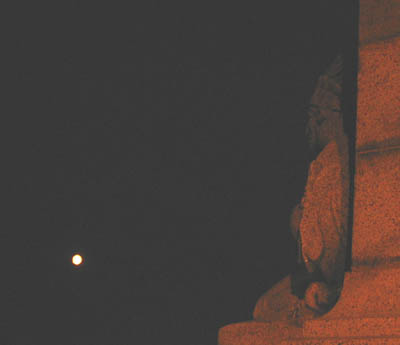Problem: For proper exposure of the full moon at night, you have a use a daylight setting on your camera; the moon is that bright. Unfortunately other objects-– buildings, statues, etc.-- are usually a lot darker compared to the moon when illuminated by your average streetlight.
So what you can end up with is an overexposed moon-– completely burned out, no detail-– and an unexposed subject on the ground at the mercy of the color temperature of the manmade lighting. Also, the moon is kinda small when shooting so close to a foreground subject with a wide-angle lens. This first photo illustrates what I mean. A small, blank moon and a dimly-lit, funky-tinted statue.

Solution: Use the camera flash to illuminate the nearby object you want included in the frame. As for the moon, take advantage of a hazy night sky that cuts down the intensity of its light. Also, zoom out to the telephoto end of your camera and shoot a separate frame of the larger moon, then combine that shot with your foreground subject using a program like Photoshop.

OK, some could accuse me of “cheating.” But photography should never be touted, whether film or digital based, as the standard of “truth”-- at least when you’re trying to be artistic.
No comments:
Post a Comment